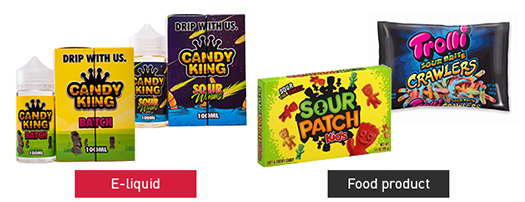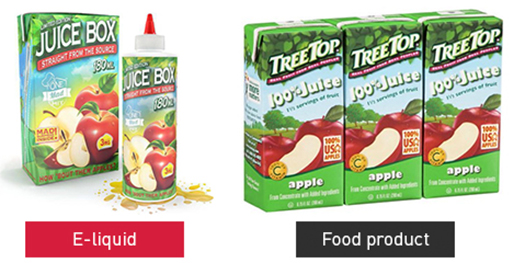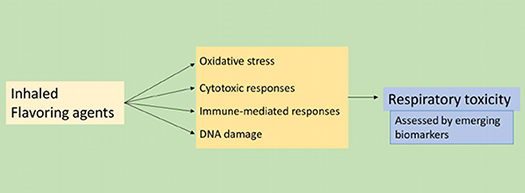News and Events
E-Cigarettes: Lies, Myths, and the Research (Part 2)
By Tracy DeCubellis
June 8, 2018
In our last article in the e-cigarette series, the chemicals in e-cigarette emissions were discussed. Now that we have evidence that nicotine and other chemicals are present in e-cigarette aerosol emissions, it’s time to focus attention on a specific ingredient in e-cigarette liquid – flavorings.
When e-cigarettes first came on the scene, it didn’t take long to see that highly flavored liquids were a main ingredient in the e-juice that is turned into the aerosol that users inhale and then exhale into the environment. There are so many flavors available through hundreds of different manufacturers and retailers. It is hard to know how many flavors there really are. One study estimates more than 8,000 different flavors are sold in the United States (Kaur, Muthumalage & Rahman, 2018). Since 2009 it has been illegal for these flavorings to be added to traditional cigarettes, but they are still available in e-cigarettes.
There was concern when e-cigarettes first came out about so many flavored e-cigarettes available because they would be attractive to kids. E-cigarette advocates often tried to refute that objection with the statement that adults like flavors, also.
Do youth start using e-cigarettes because of the flavors that are available?
According to recent research, the answer may be “yes”. In fact, among Texas youth (ages 12-17), 72.9% of those who use e-cigarettes said they started using them because “They come in flavors I like” (Harrell et al., 2017). Among youth (ages 12-17) who are current e-cigarette users, 98.6% said they used flavored e-cigarettes the first time they tried them (Harrell et al., 2017). Among adults nationwide (age 30+) who were surveyed, just 44.1% said they used e-cigarettes in a flavor other than tobacco-flavor the first time they tried them (Harrell et al., 2017).
What is the FDA doing about flavored e-cigarettes now?
In May of 2018, the FDA and the FTC issued warning letters to 13 different manufacturers or distributors because they were marketing their e-cigarette liquids to look like food or candy. In a press release on May 1, 2018, the FDA said, “No child should be using any tobacco product, and no tobacco products should be marketed in a way that endangers kids – especially by using imagery that misleads them into thinking the products are things they’d eat or drink” (U.S. Food & Drug Administration, 2018).

One of the reasons that flavored cigarettes were banned in 2009 by the Family Smoking Prevention and Tobacco Control Act was the well-documented attraction of youth to flavored tobacco products. Flavored cigarettes were often marketed in a similar manner to food or candy, just as we are seeing happen with e-cigarettes today.

How many Florida youth use e-cigarettes?
According to the Florida Youth Tobacco Survey, regular e-cigarette use (ages 11-17) has increased from 2.3% in 2012 to 11.6% in 2016 (Florida Department of Health, 2016). That is a 404% increase in the number of youth using e-cigarettes in just a four-year period. In Gilchrist County the numbers have increased from 2.8% in 2012 to 19.3% in 2016 (Florida Department of Health, 2016). On the county level that is a 589% increase in the number of our youth who are regular users of e-cigarettes!
Is it any wonder that so many young people are starting to use e-cigarettes when literally thousands of flavors are available which research now demonstrates attracts them to try the product? In fact, the same study by Harrell et al. ( 2018), shows that among all age groups who use e-cigarettes, the sweeter and fruit flavors are preferred.
What’s the harm in flavors? Aren’t fruit flavors approved by the FDA?
While flavorings are recognized as safe for consumption, they are not approved for inhalation. Every time a flavoring chemical is inhaled through e-cigarette aerosol, the lungs are being exposed to agents that might have the potential to cause cell death, DNA damage, inflammation, oxidative stress, and even immune-mediated responses in the body (Kaur, Muthumalage & Rahman, 2018).
It may be surprising to find out some of the ingredients in e-cigarette liquids. Some contain sucralose which is the active ingredient in the artificial sweetener, Splenda (Kaur, Muthumalage & Rahman, 2018). Coffee, tea, chocolate and energy drink formulas of e-cigarette flavors can also contain various levels of caffeine, which would mean the user is inhaling caffeine in addition to nicotine and other flavoring chemicals (Kaur, Muthumalage & Rahman, 2018). One of the more well-known chemicals in flavoring is diacetyl, which is common in many flavorings. Although approved for ingestion, it is known to cause bronchiolitis obliterans, or popcorn lung, when inhaled (Kaur, Muthumalage & Rahman, 2018). One study measured chemicals in 51 different e-cigarette flavors. The researchers found that 39 of the 51 flavors (76%) contained diacetyl (Allen et al., 2016).

(Kaur, Muthumalage & Rahman, 2018)
There is a concern among researchers based on both in vitro and in vivo data that flavoring in e-cigarette liquids may pose a problem in the respiratory system by causing allergic reactions, inflammation, and possible tissue damage (Kaur, Muthumalage & Rahman, 2018). We have plenty of information about the damage that cigarette smoke causes on the human body because people have been smoking them for many years. The people who use e-cigarettes, including the youth who are starting to pick up the habit, are exposing themselves to chemicals that may cause harm to their bodies while companies continue to profit from these devices.
___________________________________________________________________
References:
- Allen, J.G., Flanigan, S.S., LeBlanc, M., Vallarino, J., MacNaughton, P. et al. (2016).
Flavoring chemicals in e-cigarettes: Diacetyl, 2,3-pentanedione, and acetoin in a sample of 51 products, including fruit-, candy-, and cocktail-flavored e-cigarettes. Environmental Health Perspectives, 124(6), 733-739. - Florida Department of Health. (2016). Gilchrist youth (ages 11-17): 2012 – 2016.
Retrieved June 8, 2018, from http://www.floridahealth.gov/statistics-and-data/survey-data/florida-youth-survey/florida-youth-tobacco-survey/_documents/2016%20County/_documents/Gilchrist.pdf - Harrell, M.B., Weaver, S.R., Loukas, A., Creamer, M., Marti, C.N., et al. (2017).
Flavored e-cigarette use: Characterizing youth, young adult, and adult users. Preventative Medicine Reports, 5, 33-44. - Kaur, G., Muthamalage, T. & Rahama, I. (2018). Mechanisms of toxicity and biomarkers
of flavoring and flavor enhancing chemicals in emerging tobacco and non-tobacco products. Toxicology Letters, 288, 143-155. - U.S. Food & Drug Administration. (2018, May 1). FDA, FTC take action against
companies misleading kids with e-liquids that resemble children’s juice boxes, candies and cookies. [Press Release]. Retrieved June 8, 2018 from, https://www.fda.gov/NewsEvents/Newsroom/PressAnnouncements/ucm605507.htm




